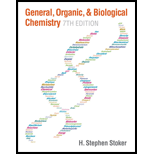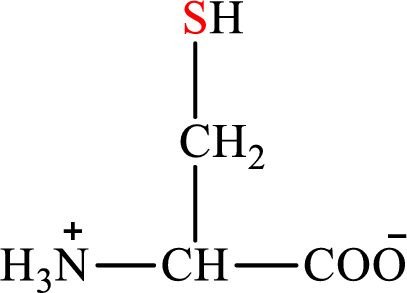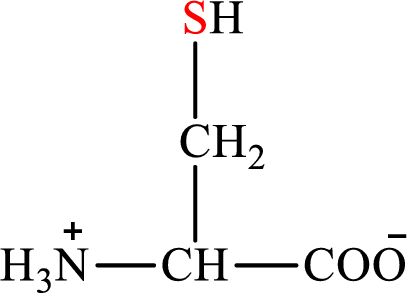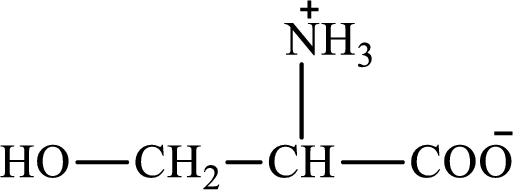
Concept explainers
(a)
Interpretation: To identify whether the statement “four of the 20 standard amino acids contain sulfur” concerning sulfur-containing amino acids is true or false.
Concept introduction: Amino acids are the
There are 20 amino acids present in nature. These are arginine, histidine, isoleucine, leucine, lysine, methionine, phenylalanine, threonine, tryptophan, valine, alanine, asparagines, aspartic acid, cysteine, glutamic acid, glutamine, glycine, proline, serine, and tyrosine.
(b)
Interpretation: To identify whether the statement “the first step in the degradation of the amino acid cysteine is a transamination reaction” concerning sulfur-containing amino acids is true or false.
Concept introduction: There are 20 amino acids present in nature. These are arginine, histidine, isoleucine, leucine, lysine, methionine, phenylalanine, threonine, tryptophan, valine, alanine, asparagines, aspartic acid, cysteine, glutamic acid, glutamine, glycine, proline, serine, and tyrosine. Only two of the twenty amino acids have a sulfur atom in their structure. The two amino acids are cysteine and methionine. The structure of cysteine is:

Cysteine gives pyruvate as the degradation product. The degradation of cysteine is a two-step process.
(c)
Interpretation: To identify whether the statement “pyruvate is the sulfur-containing product from the degradation of the amino acid cysteine” concerning sulfur-containing amino acids is true or false.
Concept introduction: There are 20 amino acids present in nature. These are arginine, histidine, isoleucine, leucine, lysine, methionine, phenylalanine, threonine, tryptophan, valine, alanine, asparagines, aspartic acid, cysteine, glutamic acid, glutamine, glycine, proline, serine, and tyrosine. Only two of the twenty amino acids have a sulfur atom in their structure. The two amino acids are cysteine and methionine. The structure of cysteine is:

Cysteine gives pyruvate as the degradation product. The degradation of cysteine is a two-step process.
(d)
Interpretation: To identify whether the statement “ATP is the activating agent in the first step of the conversion of serine to cysteine” concerning sulfur-containing amino acids is true or false.
Concept introduction: There are 20 amino acids present in nature. Only two of the twenty amino acids have a sulfur atom in their structure. Cysteine is biosynthesized from nonessential amino acid serine. The structure of cysteine is:

The structure of serine is:

Want to see the full answer?
Check out a sample textbook solution
Chapter 26 Solutions
GENERAL,ORGANIC,+BIO.CHEM.-MINDTAP
- Once cooked, egg whites remain in a solid form. However, egg whites that are beaten to form meringue will partially change back to a jellylike form if allowed to stand for a while. Explain these behaviors using the concept of reversible protein denaturation.arrow_forwardWhat functional groups are present in all -amino acids?arrow_forwardCholesterol, in spite of its bad reputation, is an essential component of: a.microtubules. b.the cell membrane. c.ribosomes. d.cytosol.arrow_forward
- 6 Where is glycogen stored in the human body?arrow_forward12. A substance derived from unsaturated fatty acids with hormone-like effects on a number of body tissues is(are) a. glucocorticoids Ob. prostaglandins c. glycocholate Od. arachidonic acidarrow_forwardWhat is the biochemical function category for each of the following types of lipids? a. sphingoglycolipids c. biological waxes 19-6 b. eicosangids d. phospholipidsarrow_forward
- Refer to Figure and answere following questions: a. People with type O blood can donate blood to anyone, but they cannot receive blood from everyone. From whom can they not receive blood? b. People with type AB blood can receive blood from anyone, but they cannot give blood to everyone. To whom can they not give blood?arrow_forward4. Food that contains all the essential amino acids in the proportions needed by the body. a. anabolism b. catabolism C. complete protein Od. complex carbohydrate e. macronutrient Of. major mineral g. metabolism h. micronutrient i. mineral j. mitochondria O k. nutrition O1. trace mineralarrow_forwardHow does the body utilize amino acids which are not needed for the synthesis of proteins and other biological molecules? A. It breaks them down. B. It stores them. C. both A and B D. neither A nor Barrow_forward
 Chemistry for Today: General, Organic, and Bioche...ChemistryISBN:9781305960060Author:Spencer L. Seager, Michael R. Slabaugh, Maren S. HansenPublisher:Cengage Learning
Chemistry for Today: General, Organic, and Bioche...ChemistryISBN:9781305960060Author:Spencer L. Seager, Michael R. Slabaugh, Maren S. HansenPublisher:Cengage Learning World of Chemistry, 3rd editionChemistryISBN:9781133109655Author:Steven S. Zumdahl, Susan L. Zumdahl, Donald J. DeCostePublisher:Brooks / Cole / Cengage Learning
World of Chemistry, 3rd editionChemistryISBN:9781133109655Author:Steven S. Zumdahl, Susan L. Zumdahl, Donald J. DeCostePublisher:Brooks / Cole / Cengage Learning World of ChemistryChemistryISBN:9780618562763Author:Steven S. ZumdahlPublisher:Houghton Mifflin College Div
World of ChemistryChemistryISBN:9780618562763Author:Steven S. ZumdahlPublisher:Houghton Mifflin College Div Introduction to General, Organic and BiochemistryChemistryISBN:9781285869759Author:Frederick A. Bettelheim, William H. Brown, Mary K. Campbell, Shawn O. Farrell, Omar TorresPublisher:Cengage Learning
Introduction to General, Organic and BiochemistryChemistryISBN:9781285869759Author:Frederick A. Bettelheim, William H. Brown, Mary K. Campbell, Shawn O. Farrell, Omar TorresPublisher:Cengage Learning General, Organic, and Biological ChemistryChemistryISBN:9781285853918Author:H. Stephen StokerPublisher:Cengage Learning
General, Organic, and Biological ChemistryChemistryISBN:9781285853918Author:H. Stephen StokerPublisher:Cengage Learning Organic And Biological ChemistryChemistryISBN:9781305081079Author:STOKER, H. Stephen (howard Stephen)Publisher:Cengage Learning,
Organic And Biological ChemistryChemistryISBN:9781305081079Author:STOKER, H. Stephen (howard Stephen)Publisher:Cengage Learning,





